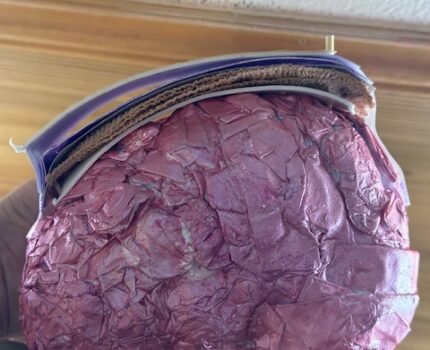My art project is about the Meningitis in Children, and my art piece represent ones of the most important organs in the body system – The brain and the spinal cord, this piece was made of paper- Mache and acrylic paint. The objectives I’m covered are the symptoms, diagnosis, global statics, describing the syndrome cause and affects in the nervous and neurologic systems in children between the age 28 days and younger of 5 years old, also I will be covering in this essay a brief explanation of how the skeletal, smooth, and cardiac muscle could got affect by the meningitis syndrome.
The human body is a complex system made of multiple organs working together to maintain homeostasis. When this balance is affected by any bacteria, viruses, and organ dysfunction could cause permanent and long-term damages. In the most several of the causes even the dead of the individual. Most of the illnesses and disease caused by bacteria and viruses are treatable with modern medicine, among these diseases, meningococcal meningitis has one of the highest fatality rates and the potential to cause devastating epidemics, (Journal of Infection disease, 2021 Report). Meningitis is an inflammation of the protective membrane covering the brain and spinal cord, known as a meninges, the meninges is made by three layers of fibrous membrane that surround the central nervous system, when these layers are affected by the illness the brain and spinal cord are unprotected again infections and other bacteria and viruses, also the spinal nerves (nervous system) and spinal column (skeletal muscle) could be affect because the spinal cord is connected with both of them. (A&P 2e, Pg. 515, 524).
According by the meningitis Research Foundation (microorganism Journal, 2021), Meningitis is a preventable syndrome cause by a bacteria or a virus and could be detected by preforming a LP or Lumbar Puncture performed by trained staff in a sterilized and medical setting. After the CSF is collected and sent to a laboratory which will continue with the process the analysis of cerebrospinal fluid (CSF), the cell count, glucose, and protein concentration from the CSF samples are used to determinate the result of cases of probable bacterial or viral meningitis (academic.oup,224). Cerebrospinal fluid is the fluid that circulates through and around the central nervous system (CNS), which dominant the region of the brain and spinal cord (A&P – 2e, Pg. 452). Because the CSF travel through the body and flow out of the cardiovascular circulation is a possibility that the heart could develop long term problems (A&P-2e, Pg.516).
An unconfirmed bacterial meningitis result will show factors such as; a decrease of glucose, elevated protein, a leukocytosis (10-100 cells/uL), and a turbid appearance. However, a confirmed case of meningitis is determinate by growing (ie, culturing) or identification of a bacterial pathogen.
The reports by the global landscape of pediatric bacterial meningitis to WHO (World Health Organization), shown the suspected cases of meningitis in children from 0 – 59 months of age present itself with symptoms such as sudden – onset fevers, neck stiffness, altered consciousness (Journal Article, DSN, 2014-2019), light sensitivity and severe headache, the most important symptoms are the neurological symptoms such as changes in mental state (A&P-2e, Pg 515) . The WHO maintain an intense control and surveillance from laboratory results around major regions of the world between 2014-2019, which release a clear result of the regions with the higher cases of bacterial meningitis, showing the African region higher in the list, following by Eastern Mediterranean and South- East Asia, those regions overall make together a 40% cases of meningitis in children younger than 5 years of age, the surveillance also predict a decrease of the actual numbers in these regions, assuming that by 2030 the population will have more abscess to vaccines and continue with an effective preventing plan again this illness (Journal of infection Disease,2021).
In conclusion meningitis is an unpredictable illness which could affect children and adults, but the mortality is higher in children during the early stages of their life. This syndrome could affect the entire system and multiples organs in the body of the individual, and even if the rate decreases in the future, still a considerable percentage of valuable life of children that the disease claims every year around the world, in regions where do not have the resources, staff, and equipment to perform the right procedure to determinates a correct and effect diagnosis. When the meninges and their protected layers got affected or compromised by any illness, the brain and the spinal cord lose their protection and could develop permanent complications because of the aftermath of the disease.
Work Cite
Anatomy and Physiology : Anatomy of the Nervous System: Vol. ISBN-13 (2e ed.). (2022). [Hardcover Book]. The Xanadu publishing, Inc.
Nakamura, T., Cohen, A. L., Schwartz, S., Mwenda, J. M., Weldegebriel, G., Biey, J. N., Katsande, R., Ghoniem, A., Fahmy, K., Rahman, H. A., Videbaek, D., Daniels, D., Singh, S., Wasley, A., Rey-Benito, G., De Oliveira, L., Ortíz, C. P., Tondo, E., Liyanage, J., . . . Serhan, F. (2021). The global landscape of Pediatric bacterial meningitis data reported to the World Health Organization–Coordinated Invasive Bacterial Vaccine-Preventable Disease Surveillance Network, 2014–2019. The Journal of Infectious Diseases, 224(Supplement_3), S161–S173. https://doi.org/10.1093/infdis/jiab217
Wright, C., Blake, N., Glennie, L., Smith, V., Bender, R. G., Kyu, H. H., Wunrow, H. Y., Liu, L., Yeung, D., Knoll, M. D., Wahl, B., Stuart, J. M., & Trotter, C. (2021). The Global Burden of Meningitis in Children: Challenges with Interpreting Global Health Estimates. Microorganisms, 9(2), 377. https://doi.org/10.3390/microorganisms9020377





https://humanap.community.uaf.edu/2023/11/21/meningitis-in-children/
Rosa’s project is about meningitis and her artwork is a model of the brain. Here you can clearly see the layers of different tissue covering the brain. She shows three layers. She states that the disease, meningitis, is an inflammation of the protective membrane covering the brain and spinal cord and identifies this as meninges. Rosa’s essay is more specific to meningitis in children. She states that the skeletal, smooth, and cardiac muscle could be affected by the disease. Rosa reports that a lumbar puncture is a type of procedure that helps detect the disease by investigating the cerebrospinal fluid. Afterwards, a culture needs to be evaluated to diagnosis meningitis. This disease is severe enough that the World Health Organization closely monitors the infection rate. Certain areas of Africa, the Mediterranean and South- East Asia make up about forty percent of pediatric cases. Many of the children in areas that are poor or unable to receive adequate healthcare will most certainly succumb to the disease as it affects the lining of the brain and the spinal cord which is part of the central nervous system. Rosa states some common symptoms include a fever, stiffness of the neck, “altered consciousness,” sensitivity to light, severe headaches, and any type of neurological change. Sometimes these symptoms occur rapidly. She says that this disease is unpredictable and if not discovered in time, could result in death or irreversible damage.